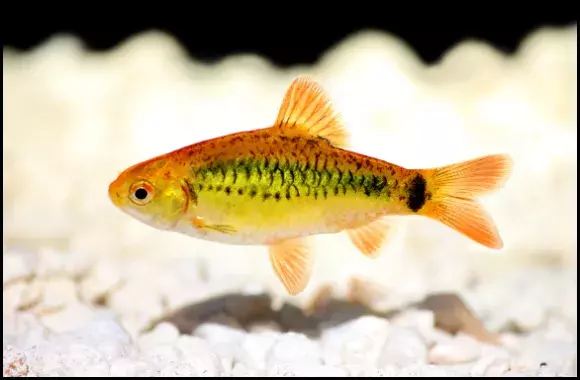
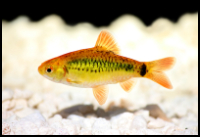
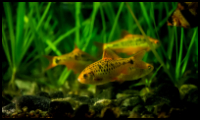
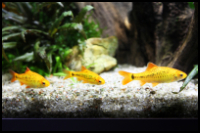
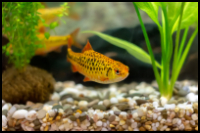
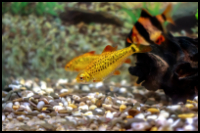
Quick Care Details (Table)
| Livestock Characteristics | Value |
|---|---|
| Care Level | Easy |
| Temperament | Semi-Agressive |
| Diet | Omnivore |
| Maximum Size | 2.5 Inches |
| Minimum Tank Size | 20 Gallons |
| Plant Safe | Yes |
| Temperature Range | 72°F to 79°F |
| PH Range | 6.0-7.5 pH |
| KH Range | 4-8 dKH |
| GH Range | 5-15 dGH |
Species Specific Categories
Helpful Video
Care Details
Aquascape
- When designing an aquascape for Golden Barbs, consider creating a natural-looking setup with plants, rocks, and driftwood.
- Use plants with fine leaves, such as stem plants or carpeting plants, to provide cover and create a lush environment.
- Incorporate rocks and driftwood strategically to create hiding spots and create a visually appealing tank layout.
- Golden Barbs appreciate open swimming areas, so ensure there is ample space for them to move around in the tank.
Substrate
- The substrate for Golden Barbs can vary based on personal preference and the type of plants being used.
- Choose a substrate that supports plant growth, such as nutrient-rich soil or a combination of gravel and root tabs.
- A darker substrate can help enhance the colors of the Golden Barbs and provide a natural aesthetic.
Disease prevention
- Maintain good water quality to prevent diseases in Golden Barbs. Regularly test water parameters and perform freshwater changes as necessary.
- Quarantine new fish before introducing them to the main tank to prevent the spread of potential diseases.
- Avoid overstocking the tank, as overcrowding can lead to stress and make the fish more susceptible to diseases.
- Provide a balanced diet and avoid overfeeding to prevent the accumulation of uneaten food, which can negatively impact water quality.
Filtration
- Choose a filtration system suitable for the size of the aquarium. A combination of mechanical, biological, and chemical filtration is recommended.
- Ensure efficient water circulation and oxygenation to maintain good freshwater quality and provide a healthy environment for the fish and plants.
- Clean or replace filter media regularly to maintain optimal filtration efficiency.
Lighting
- Provide moderate to high-intensity lighting to support plant growth in the aquascape.
- Use full-spectrum lights that promote healthy photosynthesis and enhance the colors of both the fish and plants.
- Implement a lighting schedule of around 8 to 10 hours per day to simulate a natural day-night cycle.
Water Flow
- Golden Barbs prefer moderate water flow in the aquarium, mimicking their natural habitat.
- Use a filter outlet or a powerhead to create gentle water movement throughout the tank.
- Ensure there are areas with calm water where the Golden Barbs can rest and swim comfortably.
- Avoid strong currents that may stress or exhaust the fish.
Temperament and Behavior
Behavior
- Golden Barbs are active and lively fish that are known for their energetic swimming behavior.
- They are generally peaceful and sociable, making them suitable for community aquariums.
- Males may exhibit occasional territorial behavior, especially during breeding or when establishing hierarchy within a group.
- They are generally active swimmers and appreciate open spaces for swimming.
Breeding
- Breeding Golden Barbs can be achieved in a well-maintained aquarium with proper conditions.
- Set up a separate breeding tank with plants and fine-leaved spawning mops or mesh for the eggs.
- Introduce a group of males and females into the breeding tank, with a ratio of two or three females per male.
- Provide optimal water conditions with slightly acidic to neutral pH (around 6.0-7.5) and a temperature of 75°F to 79°F (24°C to 26°C).
- The female will scatter adhesive eggs among the plants or spawning mop, and the male will fertilize them. After spawning, remove the adults to protect the eggs.
- The eggs typically hatch within a few days, and the fry can be fed with powdered or finely crushed flake foods until they are large enough to consume larger foods.
Compatibility
- Golden Barbs are generally peaceful and can be kept with a variety of other peaceful community fish.
- They are compatible with small to medium-sized fish that share similar freshwater parameter requirements.
- Suitable tankmates include tetras, rasboras, danios, dwarf gouramis, peaceful bottom-dwellers like Corydoras catfish, and other peaceful barb species.
- Avoid keeping them with aggressive or fin-nipping species, as their long flowing fins may be targets for harassment.
Tank mates
- Golden Barbs are generally compatible with a wide range of peaceful tank mates.
- Suitable tank mates include small tetras like Neon Tetras or Ember Tetras, peaceful rasboras like Harlequin Rasboras, peaceful danios like Zebra Danios, and small peaceful gouramis.
- They can also be kept with bottom-dwelling species such as Corydoras catfish or small loaches as tank mates.
- Avoid keeping them with aggressive or fin-nipping species, as their long flowing fins may be targets for aggression.
Activity Level
- Golden Barbs are known for their energetic and active behavior.
- They are constant swimmers, often exploring all areas of the tank, from top to bottom.
- Providing open swimming areas and plenty of hiding spots with plants, rocks, and driftwood can help accommodate their active nature.
Clean up Crew
- Golden Barbs are not typically considered "clean-up crew" fish.
- They do not have a specific role in actively cleaning the tank or consuming algae or detritus.
- However, they may occasionally nibble on soft algae or small food particles as they forage for food.
Diet and Nutrition
Dry Foods
- Gold Barbs readily accept high-quality dry foods like flakes or pellets.
- Look for commercially available fish foods that are specifically formulated for tropical fish or omnivorous species.
- Ensure that the dry foods you choose provide a balanced diet with a combination of proteins, carbohydrates, vitamins, and minerals.
- It's recommended to offer a variety of dry foods to provide nutritional diversity and keep the fish's diet interesting.
Frozen Foods
- Frozen foods are a great option to provide variety and nutrition to Gold Barbs.
- Offer them frozen or thawed foods such as brine shrimp, bloodworms, daphnia, or cyclops.
- These foods are rich in proteins and nutrients, contributing to the overall health and coloration of the fish.
- Feed frozen foods sparingly, as they can be high in protein and fat. Use them as a supplement to a balanced diet.
Live Foods
- Gold Barbs enjoy live foods, and they can be a nutritious addition to their diet.
- Offer them live foods such as brine shrimp, daphnia, mosquito larvae, or small worms like blackworms or tubifex worms.
- Live foods provide essential proteins and stimulate their natural feeding behaviors.
- Ensure that live foods are from reputable sources to avoid introducing potential diseases or parasites to the aquarium.
Vegetables
- While Gold Barbs are primarily omnivorous, they may not readily consume vegetables like some other fish species.
- However, you can try offering blanched or boiled vegetables like spinach, zucchini, cucumber, or peas.
- Cut the vegetables into small, manageable pieces and ensure they are soft enough for the fish to consume.
- Some Gold Barbs may show interest in nibbling on the vegetable matter, but individual preferences can vary.
Algae
- Gold Barbs are not specialized algae eaters and typically do not rely on algae as a significant part of their diet.
- While they may nibble on soft or filamentous algae occasionally, it should not be their primary food source.
- Providing a well-balanced diet that includes a combination of dry foods, frozen foods, and occasional live foods is essential to meet their nutritional needs.
Tank Parameters
Tank size
- The recommended tank size for a group of Golden Barbs is at least 20 gallons (75 liters).
- Providing a larger tank allows for more swimming space and accommodates their active nature.
Tank Length
- Golden Barbs are relatively small fish, with adult males reaching a maximum length of about 2 inches (5 centimeters).
- A tank length of 24 inches (60 centimeters) or more is suitable to allow them ample space for swimming and exploring.
Water Temperature
- Golden Barbs prefer a tropical water temperature range of around 72°F to 79°F (22°C to 26°C).
- Maintaining a stable freshwater temperature within this range is crucial for their well-being and overall health.
pH (Acidity/Alkalinity)
- Golden Barbs can adapt to a range of pH levels but generally prefer slightly acidic to neutral water conditions.
- The recommended pH range for Golden Barbs is around 6.0 to 7.5.
- It's important to maintain stable water parameters, as sudden fluctuations in pH can be stressful for the fish.
KH (Carbonate Hardness)
- The recommended KH (carbonate hardness) for Golden Barbs is in the range of 4 to 8 dKH (degrees of carbonate hardness).
- Carbonate hardness helps stabilize pH levels and provides buffering capacity against pH swings.
GH (General Hardness)
- Golden Barbs are adaptable to a range of GH (general hardness) levels.
- The recommended GH range for Golden Barbs is between 5 to 15 dGH (degrees of general hardness).
- GH represents the overall mineral content in the water, including calcium and magnesium.
Hardiness
- Golden Barbs are considered relatively hardy fish, making them suitable for beginner aquarists.
- They can tolerate a range of water parameters, given that they are within acceptable limits and remain stable.
- However, providing optimal water conditions is still important to promote their overall health and well-being.
Nitrate (NO3) levels
- Nitrate (NO3) is a common byproduct of the nitrogen cycle in the aquarium and can accumulate over time.
- It's important to monitor nitrate levels and keep them below 20-40 ppm (parts per million) for the well-being of the fish.
- Regular water changes and proper filtration can help control nitrate levels and maintain good water quality.
History, Popularity, History and Species Variety Details
The History, Popularity and Habitat of the Gold Barb
The history of the Golden Barb (Pethia gelius) can be traced back to its origins in India and Bangladesh, where it naturally occurs in various river systems and water bodies. The species belongs to the family Cyprinidae, which includes numerous other popular aquarium fish species.
The Gold Barb has a long and interesting history, starting with its recognition as a beautiful and vibrant fish native to the freshwater habitats of its native range. As these fish gained popularity among aquarists and fishkeepers worldwide, their presence in the aquarium trade gradually grew.
The exact timeline of the introduction of Gold Barbs into the aquarium hobby is not extensively documented. However, they have been available in the trade for several decades. Over time, their captivating golden coloration and active nature caught the attention of hobbyists, making them sought after for community aquariums.
Selective breeding efforts have played a role in enhancing the golden coloration of these fish, further emphasizing their striking appearance. Breeders and hobbyists have worked to develop strains with deeper and more intense golden hues, resulting in variations within the Gold Barb population.
Through the years, the Gold Barb has become established in the aquarium trade and has found its way into tanks of hobbyists around the world. Their popularity stems from their vibrant colors, active behavior, and overall hardiness.
Despite their popularity, the conservation status of Gold Barbs in the wild is not extensively studied or of concern at this time. However, their natural habitats face ongoing threats such as habitat degradation, water pollution, and overfishing. Responsible and sustainable collection practices, as well as the success of breeding programs in captivity, have helped reduce pressure on wild populations.
Today, the Gold Barb continues to be cherished and enjoyed by aquarium enthusiasts worldwide. Their elegant and radiant appearance, coupled with their peaceful nature, make them an attractive addition to community aquariums. Their ability to adapt to a wide range of water parameters and relative ease of care have contributed to their popularity among both beginner and experienced aquarists.
As the popularity of the Gold Barb continues to grow, it is crucial for hobbyists to support sustainable and responsible practices, such as captive breeding and conservation efforts, to ensure the continued availability of these beautiful fish for future generations to appreciate and enjoy.
Types of Golden Barb Variations
- Golden Tiger Barb (Puntius tetrazona): Tiger Barbs are popular aquarium fish with bold black stripes on a gold or orange body. The Golden Tiger Barb is a color variation where the black stripes are reduced or absent, leaving a more prominent golden coloration.
- Golden Rosy Barb (Pethia conchonius): Rosy Barbs are attractive fish with a rosy-pink body. The Golden Rosy Barb is a color variation with a brighter gold or yellow body color.
- Golden Checkered Barb (Puntius oligolepis): Checkered Barbs have a striking checkered pattern on their body. The Golden Checkered Barb is a color variation with a more pronounced golden hue.
- Golden Dwarf Barb (Barbus semifasciolatus): Also known as the Dwarf Golden Barb, this species is a smaller variation of the Chinese Golden Barb, with a similar golden body color.
Male gender vs Female gender of The Golden Barb (Sexual Dimorphism)
- Size and Body Shape
- Mature males are generally smaller and more slender compared to females.
- Females tend to have a fuller and rounder body shape, especially when they are carrying eggs.
- Coloration
- During the breeding season or when displaying courtship behavior, males may exhibit more vibrant and intense coloration.
- Males often have more pronounced golden-yellow hues, especially on their fins.
- Females usually have a more subdued coloration and may appear lighter or duller in comparison.
- Fins
- Males typically have more elongated and pointed dorsal fins compared to females, which can be more rounded.
- The anal fin of males may be thicker and more elongated compared to the females.
- Vent Area
- In mature females, the vent area, located just behind the anal fin, may appear more rounded and swollen, indicating the presence of eggs.
- Behavior
- During the breeding season, males may exhibit more active and territorial behavior, chasing females and displaying courtship rituals.
- Females may appear less aggressive and spend more time seeking suitable spawning sites or hiding places.
Breeding Golden Barbs
- Setting up a Breeding Tank
- Prepare a separate breeding tank with a capacity of at least 10 gallons (38 liters).
- Use a sponge or pre-filter to prevent the fry from being sucked into the filtration system.
- Create suitable spawning sites by adding fine-leaved plants, such as Java moss or spawning mops, where the fish can lay their eggs.
- Selecting Breeding Pairs
- Introduce a compatible breeding pair into the breeding tank.
- It is best to have a ratio of one male to two or three females to increase breeding success and reduce male aggression.
- Conditioning the Breeding Pair
- Prior to breeding, provide the breeding pair with a nutritious diet to condition them for spawning.
- Offer a variety of high-quality live and frozen foods, such as brine shrimp, bloodworms, or daphnia, to enhance their overall health and reproductive readiness.
- Simulating Breeding Conditions
- Increase the water temperature in the breeding tank to around 75°F to 79°F (24°C to 26°C), as this can stimulate breeding behavior.
- Adjust the lighting period to approximately 12 hours of light and 12 hours of darkness to mimic natural day-night cycles.
- Observing Courtship Behavior
- Males may display intensified colors, particularly on their fins, and exhibit courtship behaviors such as chasing and displaying to attract females.
- Females might become plumper and display receptive behavior, swimming near the males and showing interest in the males' courtship displays.
- Spawning and Egg Laying
- During spawning, the male will chase the female among the plants or spawning mops, where the female will release adhesive eggs.
- The male will then fertilize the eggs by releasing milt (sperm) over them.
- The process may be repeated multiple times, resulting in the scattering of eggs throughout the spawning area.
- Removing the Adults
- Once spawning is complete, it is essential to remove the adult fish from the breeding tank to prevent them from eating the eggs.
- Transfer them back to their original tank or a separate holding tank.
- Hatching and Fry Care
- The eggs typically hatch within 24 to 48 hours, depending on water temperature.
- Once the fry have hatched, they will attach themselves to plants or other surfaces using sticky threads.
- Feed the fry with infusoria, liquid fry food, or powdered commercial fry food initially, and gradually introduce newly hatched brine shrimp or finely crushed flake foods as they grow.
- Water Quality and Maintenance
- Monitor and maintain optimal water quality parameters, including temperature, pH, and ammonia levels.
- Perform regular water changes to keep the water clean and ensure good conditions for the developing fry.
Frequently Asked Questions
Are Golden Barbs compatible with shrimp or snails?
Gold Barbs may occasionally show interest in small shrimp or snails, especially if they are small enough to fit in their mouths. It's best to exercise caution and monitor their behavior when keeping them together.
Do Golden Barbs jump out of the tank?
Golden Barbs have been known to jump occasionally, so it's important to provide a secure lid or cover on the aquarium to prevent them from escaping.
How long do Golden Barbs live?
With proper care, Golden Barbs can live for several years, typically around 4 to 6 years in captivity.
Can Golden Barbs be bred in home aquariums?
Yes, Golden Barbs can be bred in home aquariums. A separate breeding tank with suitable spawning sites and optimal water conditions is necessary to encourage spawning and protect the eggs.
What water parameters do Golden Barbs prefer?
Golden Barbs prefer slightly acidic to neutral water conditions. The recommended pH range is around 6.0 to 7.5, with a temperature range of 72°F to 79°F (22°C to 26°C).
What should I feed my Golden Barbs?
Golden Barbs are omnivorous. They can be fed a variety of foods including high-quality dry flakes or pellets, frozen foods like brine shrimp or bloodworms, and occasionally live foods like daphnia or mosquito larvae.
Can Golden Barbs be kept with other fish species?
Yes, Golden Barbs are generally peaceful and can be kept with other peaceful community fish. However, avoid keeping them with aggressive or fin-nipping species.
How many Golden Barbs should be kept together?
Golden Barbs are social fish and prefer to be kept in small groups. It is recommended to keep them in groups of at least six individuals.
Are Golden Barbs suitable for beginners?
Yes, Golden Barbs are considered suitable for beginner fishkeepers. They are relatively hardy and adaptable.
Can Golden Barbs be kept in a community aquarium with other barb species?
Golden Barbs can be kept with other peaceful barb species in a community tank. However, it's important to consider the specific requirements and compatibility of each barb species to ensure a harmonious environment. Avoid mixing Golden Barbs with more aggressive or fin-nipping barb species.
Can Golden Barbs live in a pond?
Golden Barbs can be kept in outdoor ponds if the climate is suitable and the pond provides appropriate water conditions, hiding spots, and adequate filtration. However, ensure that the pond is secure from predators and provides proper shelter and food sources for the fish.
What is the maximum size of a golden barb?
The maximum size of a Gold Barb (Pethia gelius) is typically around 2 inches (5 centimeters) for males, while females can grow slightly larger, reaching around 2.5 inches (6 centimeters). These sizes are based on the average measurements of adult Golden Barbs in home aquariums. It's important to note that individual fish may vary in size due to genetic factors, diet, and overall health. Providing proper care and a suitable environment can help ensure that Golden Barbs reach their maximum potential size.
Can a gold barb live in a marine environment?
No, a gold barb can not live with brackish fish or saltwater fish. The should live in a fully freshwater environment.

